Arts 10 Quarter 4 Module 2: Different Roles in Play Production
VerifiedAdded on 2022/09/05
|21
|4483
|32
Homework Assignment
AI Summary
This module, designed for Grade 10 Arts students, delves into the diverse roles within a play production. It begins by explaining the importance of a production team and then meticulously outlines the responsibilities of each member, including the producer, director, playwright, production manager, set designer, lighting designer, costume designer, and choreographer. The module includes pre-assessments, true or false questions, and picture analysis to test and reinforce understanding of the key concepts. Students will learn about the director's vision, the playwright's script, and the designers' contributions to the visual and auditory aspects of a stage play. The content emphasizes how each role contributes to the overall success of a theatrical production. The module also covers the visual components of a stage play, such as stage design, costume, and props, and the role of lighting design in enhancing the mood and atmosphere of the performance.
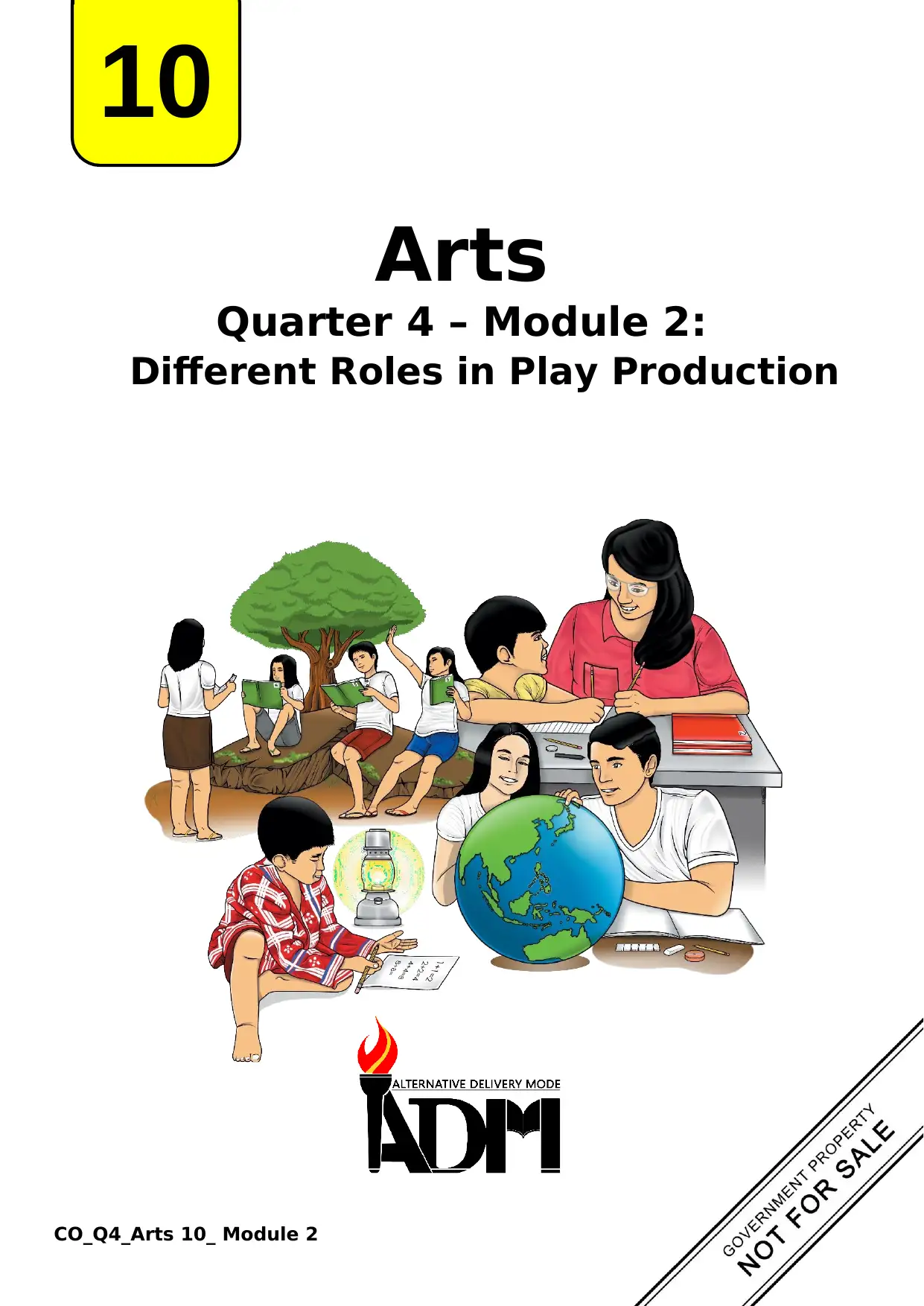
10
Arts
Quarter 4 – Module 2:
Different Roles in Play Production
CO_Q4_Arts 10_ Module 2
Arts
Quarter 4 – Module 2:
Different Roles in Play Production
CO_Q4_Arts 10_ Module 2
Paraphrase This Document
Need a fresh take? Get an instant paraphrase of this document with our AI Paraphraser
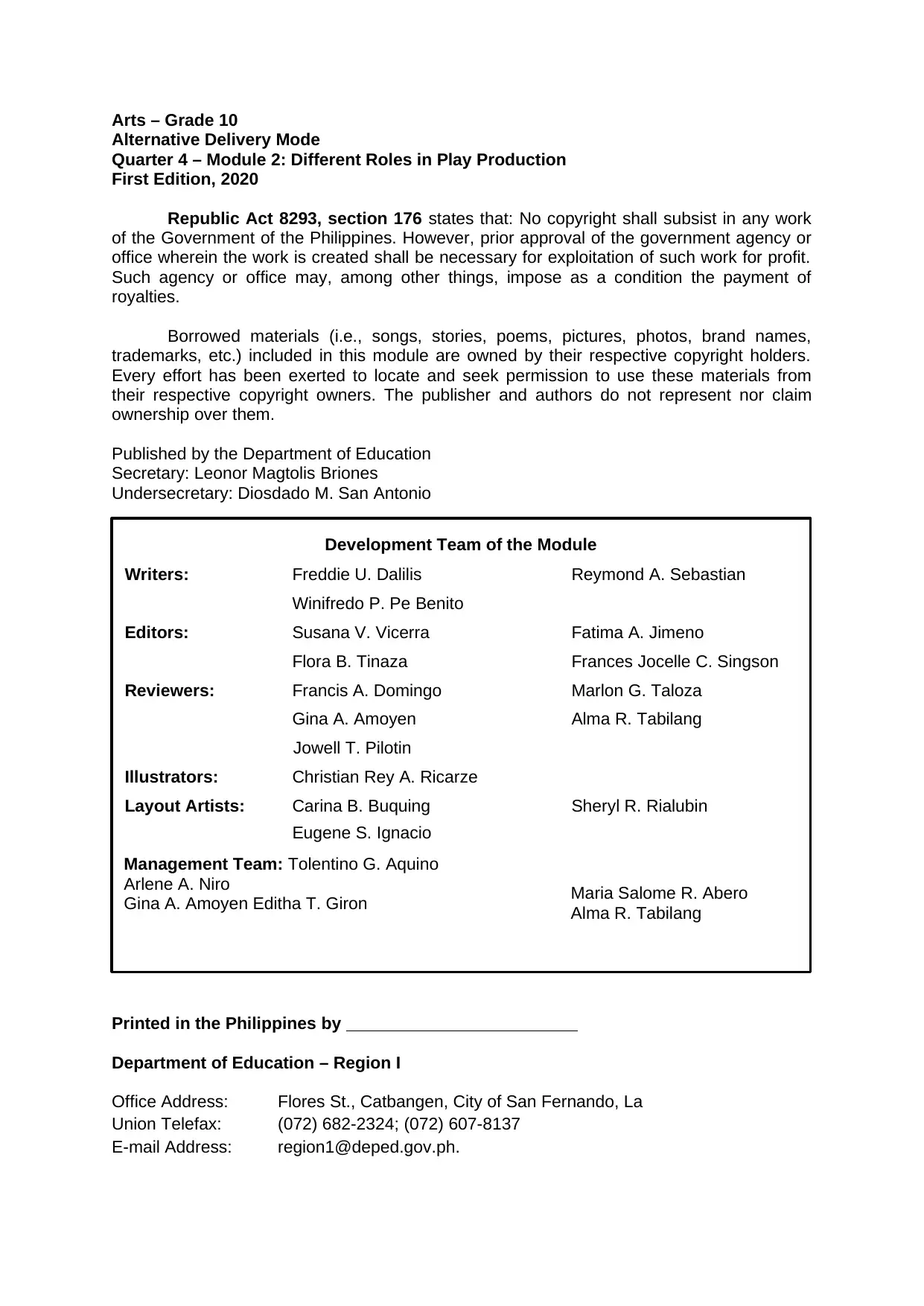
Development Team of the Module
Management Team: Tolentino G. Aquino
Arlene A. Niro
Gina A. Amoyen Editha T. Giron Maria Salome R. Abero
Alma R. Tabilang
Arts – Grade 10
Alternative Delivery Mode
Quarter 4 – Module 2: Different Roles in Play Production
First Edition, 2020
Republic Act 8293, section 176 states that: No copyright shall subsist in any work
of the Government of the Philippines. However, prior approval of the government agency or
office wherein the work is created shall be necessary for exploitation of such work for profit.
Such agency or office may, among other things, impose as a condition the payment of
royalties.
Borrowed materials (i.e., songs, stories, poems, pictures, photos, brand names,
trademarks, etc.) included in this module are owned by their respective copyright holders.
Every effort has been exerted to locate and seek permission to use these materials from
their respective copyright owners. The publisher and authors do not represent nor claim
ownership over them.
Published by the Department of Education
Secretary: Leonor Magtolis Briones
Undersecretary: Diosdado M. San Antonio
Writers: Freddie U. Dalilis Reymond A. Sebastian
Winifredo P. Pe Benito
Editors: Susana V. Vicerra Fatima A. Jimeno
Flora B. Tinaza Frances Jocelle C. Singson
Reviewers: Francis A. Domingo Marlon G. Taloza
Gina A. Amoyen Alma R. Tabilang
Jowell T. Pilotin
Illustrators: Christian Rey A. Ricarze
Layout Artists: Carina B. Buquing Sheryl R. Rialubin
Eugene S. Ignacio
Printed in the Philippines by
Department of Education – Region I
Office Address: Flores St., Catbangen, City of San Fernando, La
Union Telefax: (072) 682-2324; (072) 607-8137
E-mail Address: region1@deped.gov.ph.
Management Team: Tolentino G. Aquino
Arlene A. Niro
Gina A. Amoyen Editha T. Giron Maria Salome R. Abero
Alma R. Tabilang
Arts – Grade 10
Alternative Delivery Mode
Quarter 4 – Module 2: Different Roles in Play Production
First Edition, 2020
Republic Act 8293, section 176 states that: No copyright shall subsist in any work
of the Government of the Philippines. However, prior approval of the government agency or
office wherein the work is created shall be necessary for exploitation of such work for profit.
Such agency or office may, among other things, impose as a condition the payment of
royalties.
Borrowed materials (i.e., songs, stories, poems, pictures, photos, brand names,
trademarks, etc.) included in this module are owned by their respective copyright holders.
Every effort has been exerted to locate and seek permission to use these materials from
their respective copyright owners. The publisher and authors do not represent nor claim
ownership over them.
Published by the Department of Education
Secretary: Leonor Magtolis Briones
Undersecretary: Diosdado M. San Antonio
Writers: Freddie U. Dalilis Reymond A. Sebastian
Winifredo P. Pe Benito
Editors: Susana V. Vicerra Fatima A. Jimeno
Flora B. Tinaza Frances Jocelle C. Singson
Reviewers: Francis A. Domingo Marlon G. Taloza
Gina A. Amoyen Alma R. Tabilang
Jowell T. Pilotin
Illustrators: Christian Rey A. Ricarze
Layout Artists: Carina B. Buquing Sheryl R. Rialubin
Eugene S. Ignacio
Printed in the Philippines by
Department of Education – Region I
Office Address: Flores St., Catbangen, City of San Fernando, La
Union Telefax: (072) 682-2324; (072) 607-8137
E-mail Address: region1@deped.gov.ph.
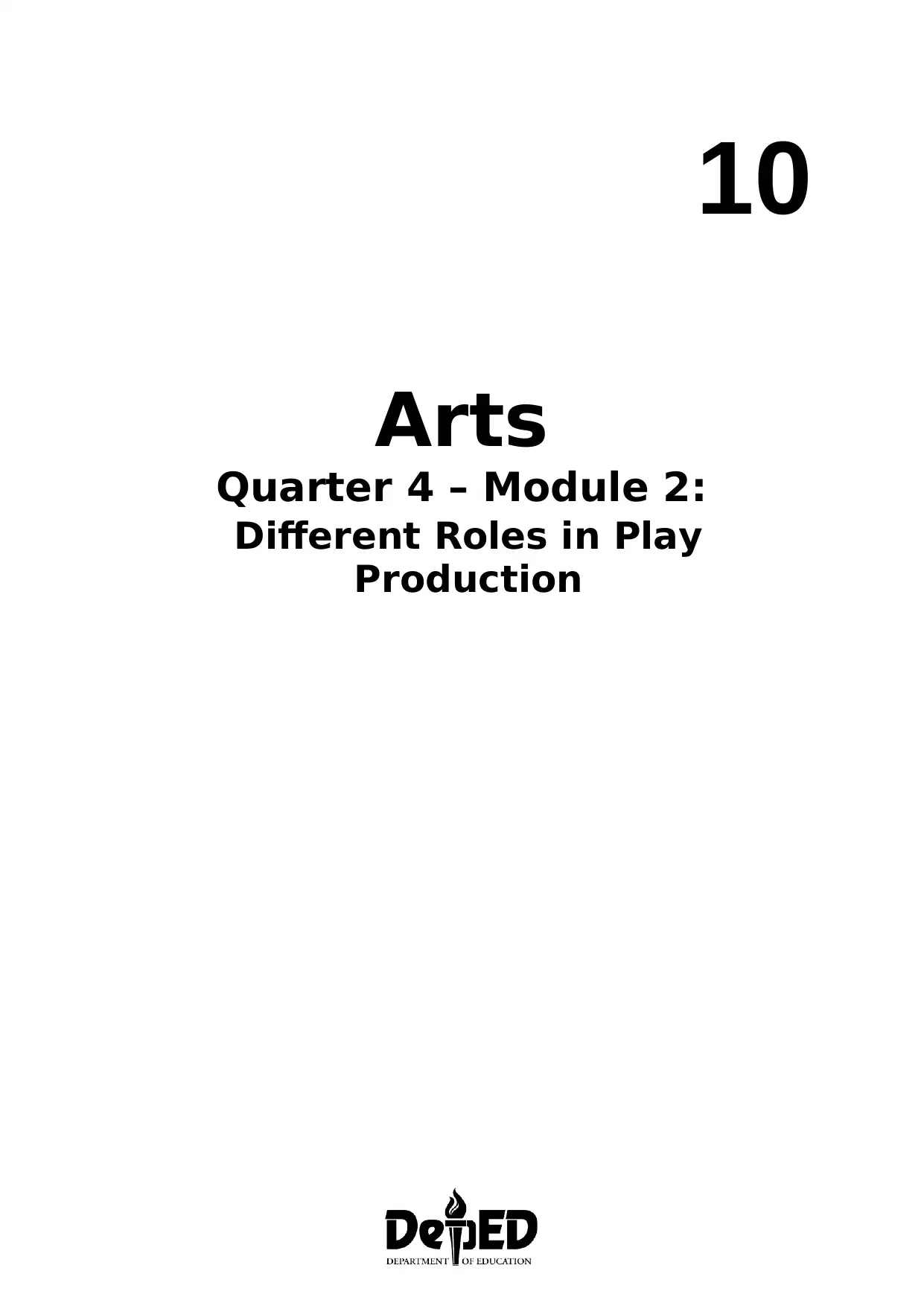
10
Arts
Quarter 4 – Module 2:
Different Roles in Play
Production
Arts
Quarter 4 – Module 2:
Different Roles in Play
Production
⊘ This is a preview!⊘
Do you want full access?
Subscribe today to unlock all pages.

Trusted by 1+ million students worldwide
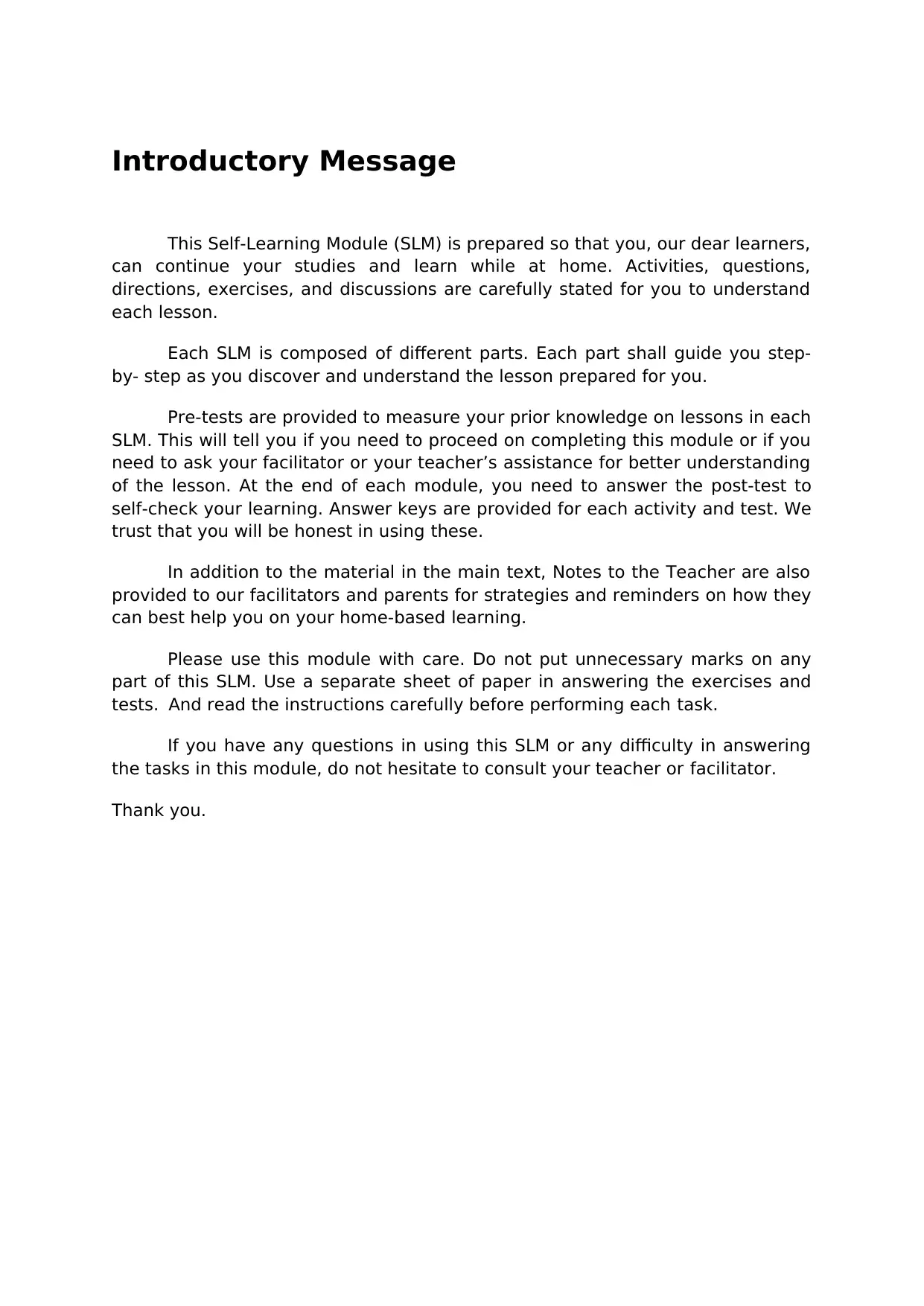
Introductory Message
This Self-Learning Module (SLM) is prepared so that you, our dear learners,
can continue your studies and learn while at home. Activities, questions,
directions, exercises, and discussions are carefully stated for you to understand
each lesson.
Each SLM is composed of different parts. Each part shall guide you step-
by- step as you discover and understand the lesson prepared for you.
Pre-tests are provided to measure your prior knowledge on lessons in each
SLM. This will tell you if you need to proceed on completing this module or if you
need to ask your facilitator or your teacher’s assistance for better understanding
of the lesson. At the end of each module, you need to answer the post-test to
self-check your learning. Answer keys are provided for each activity and test. We
trust that you will be honest in using these.
In addition to the material in the main text, Notes to the Teacher are also
provided to our facilitators and parents for strategies and reminders on how they
can best help you on your home-based learning.
Please use this module with care. Do not put unnecessary marks on any
part of this SLM. Use a separate sheet of paper in answering the exercises and
tests. And read the instructions carefully before performing each task.
If you have any questions in using this SLM or any difficulty in answering
the tasks in this module, do not hesitate to consult your teacher or facilitator.
Thank you.
This Self-Learning Module (SLM) is prepared so that you, our dear learners,
can continue your studies and learn while at home. Activities, questions,
directions, exercises, and discussions are carefully stated for you to understand
each lesson.
Each SLM is composed of different parts. Each part shall guide you step-
by- step as you discover and understand the lesson prepared for you.
Pre-tests are provided to measure your prior knowledge on lessons in each
SLM. This will tell you if you need to proceed on completing this module or if you
need to ask your facilitator or your teacher’s assistance for better understanding
of the lesson. At the end of each module, you need to answer the post-test to
self-check your learning. Answer keys are provided for each activity and test. We
trust that you will be honest in using these.
In addition to the material in the main text, Notes to the Teacher are also
provided to our facilitators and parents for strategies and reminders on how they
can best help you on your home-based learning.
Please use this module with care. Do not put unnecessary marks on any
part of this SLM. Use a separate sheet of paper in answering the exercises and
tests. And read the instructions carefully before performing each task.
If you have any questions in using this SLM or any difficulty in answering
the tasks in this module, do not hesitate to consult your teacher or facilitator.
Thank you.
Paraphrase This Document
Need a fresh take? Get an instant paraphrase of this document with our AI Paraphraser
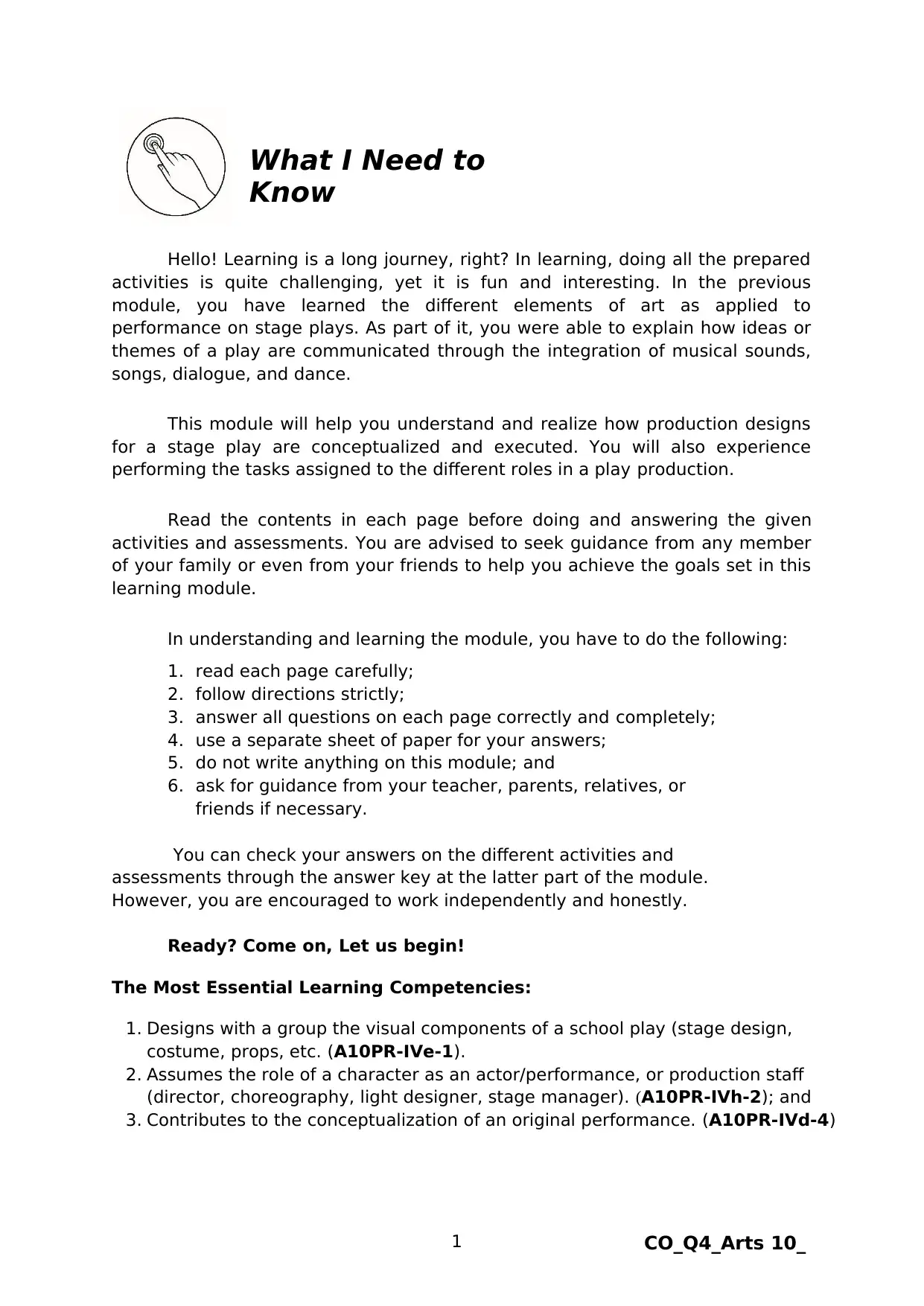
CO_Q4_Arts 10_
Module 2
1
What I Need to
Know
Hello! Learning is a long journey, right? In learning, doing all the prepared
activities is quite challenging, yet it is fun and interesting. In the previous
module, you have learned the different elements of art as applied to
performance on stage plays. As part of it, you were able to explain how ideas or
themes of a play are communicated through the integration of musical sounds,
songs, dialogue, and dance.
This module will help you understand and realize how production designs
for a stage play are conceptualized and executed. You will also experience
performing the tasks assigned to the different roles in a play production.
Read the contents in each page before doing and answering the given
activities and assessments. You are advised to seek guidance from any member
of your family or even from your friends to help you achieve the goals set in this
learning module.
In understanding and learning the module, you have to do the following:
1. read each page carefully;
2. follow directions strictly;
3. answer all questions on each page correctly and completely;
4. use a separate sheet of paper for your answers;
5. do not write anything on this module; and
6. ask for guidance from your teacher, parents, relatives, or
friends if necessary.
You can check your answers on the different activities and
assessments through the answer key at the latter part of the module.
However, you are encouraged to work independently and honestly.
Ready? Come on, Let us begin!
The Most Essential Learning Competencies:
1. Designs with a group the visual components of a school play (stage design,
costume, props, etc. (A10PR-IVe-1).
2. Assumes the role of a character as an actor/performance, or production staff
(director, choreography, light designer, stage manager). (A10PR-IVh-2); and
3. Contributes to the conceptualization of an original performance. (A10PR-IVd-4)
Module 2
1
What I Need to
Know
Hello! Learning is a long journey, right? In learning, doing all the prepared
activities is quite challenging, yet it is fun and interesting. In the previous
module, you have learned the different elements of art as applied to
performance on stage plays. As part of it, you were able to explain how ideas or
themes of a play are communicated through the integration of musical sounds,
songs, dialogue, and dance.
This module will help you understand and realize how production designs
for a stage play are conceptualized and executed. You will also experience
performing the tasks assigned to the different roles in a play production.
Read the contents in each page before doing and answering the given
activities and assessments. You are advised to seek guidance from any member
of your family or even from your friends to help you achieve the goals set in this
learning module.
In understanding and learning the module, you have to do the following:
1. read each page carefully;
2. follow directions strictly;
3. answer all questions on each page correctly and completely;
4. use a separate sheet of paper for your answers;
5. do not write anything on this module; and
6. ask for guidance from your teacher, parents, relatives, or
friends if necessary.
You can check your answers on the different activities and
assessments through the answer key at the latter part of the module.
However, you are encouraged to work independently and honestly.
Ready? Come on, Let us begin!
The Most Essential Learning Competencies:
1. Designs with a group the visual components of a school play (stage design,
costume, props, etc. (A10PR-IVe-1).
2. Assumes the role of a character as an actor/performance, or production staff
(director, choreography, light designer, stage manager). (A10PR-IVh-2); and
3. Contributes to the conceptualization of an original performance. (A10PR-IVd-4)
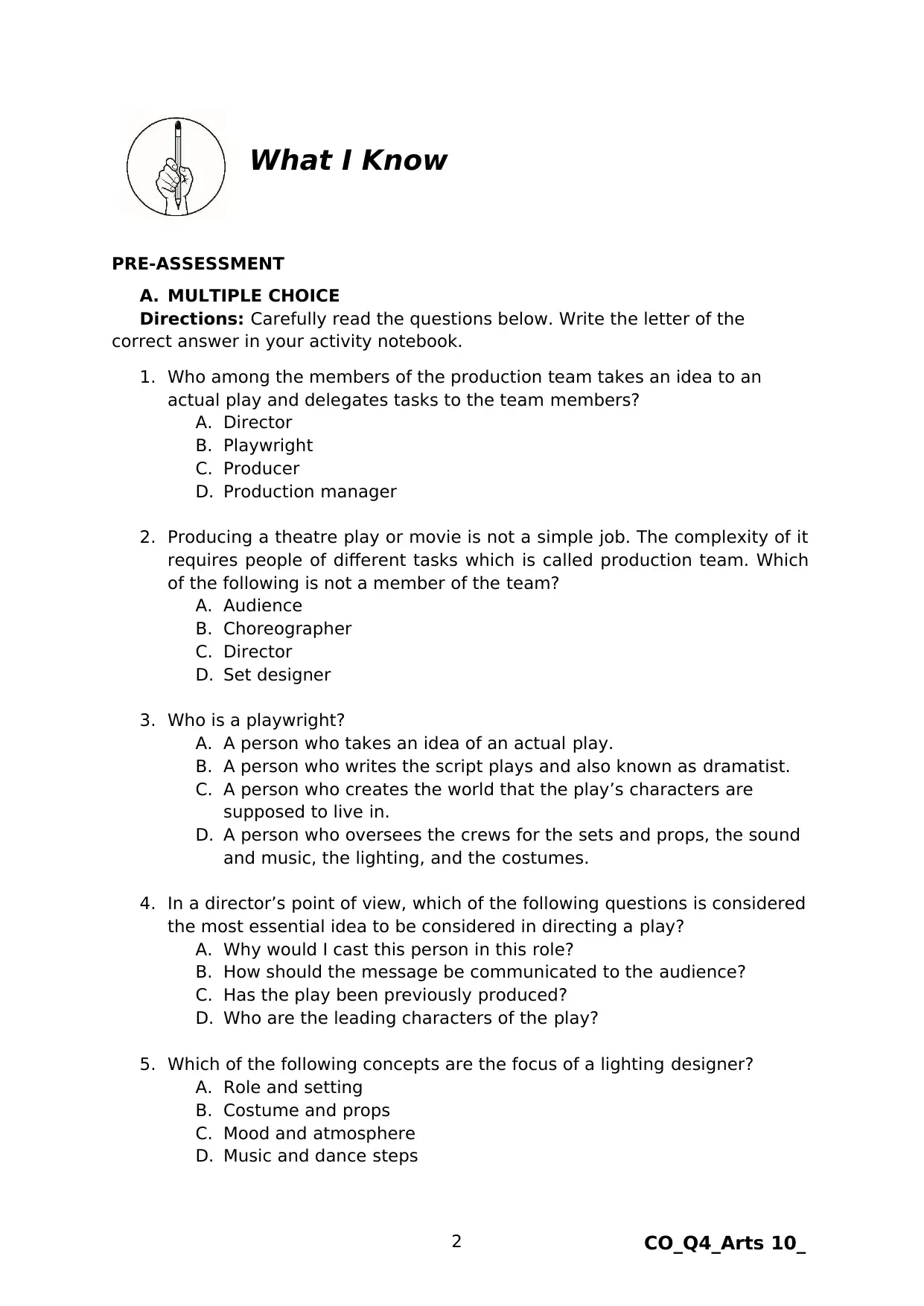
CO_Q4_Arts 10_
Module 2
2
What I Know
PRE-ASSESSMENT
A. MULTIPLE CHOICE
Directions: Carefully read the questions below. Write the letter of the
correct answer in your activity notebook.
1. Who among the members of the production team takes an idea to an
actual play and delegates tasks to the team members?
A. Director
B. Playwright
C. Producer
D. Production manager
2. Producing a theatre play or movie is not a simple job. The complexity of it
requires people of different tasks which is called production team. Which
of the following is not a member of the team?
A. Audience
B. Choreographer
C. Director
D. Set designer
3. Who is a playwright?
A. A person who takes an idea of an actual play.
B. A person who writes the script plays and also known as dramatist.
C. A person who creates the world that the play’s characters are
supposed to live in.
D. A person who oversees the crews for the sets and props, the sound
and music, the lighting, and the costumes.
4. In a director’s point of view, which of the following questions is considered
the most essential idea to be considered in directing a play?
A. Why would I cast this person in this role?
B. How should the message be communicated to the audience?
C. Has the play been previously produced?
D. Who are the leading characters of the play?
5. Which of the following concepts are the focus of a lighting designer?
A. Role and setting
B. Costume and props
C. Mood and atmosphere
D. Music and dance steps
Module 2
2
What I Know
PRE-ASSESSMENT
A. MULTIPLE CHOICE
Directions: Carefully read the questions below. Write the letter of the
correct answer in your activity notebook.
1. Who among the members of the production team takes an idea to an
actual play and delegates tasks to the team members?
A. Director
B. Playwright
C. Producer
D. Production manager
2. Producing a theatre play or movie is not a simple job. The complexity of it
requires people of different tasks which is called production team. Which
of the following is not a member of the team?
A. Audience
B. Choreographer
C. Director
D. Set designer
3. Who is a playwright?
A. A person who takes an idea of an actual play.
B. A person who writes the script plays and also known as dramatist.
C. A person who creates the world that the play’s characters are
supposed to live in.
D. A person who oversees the crews for the sets and props, the sound
and music, the lighting, and the costumes.
4. In a director’s point of view, which of the following questions is considered
the most essential idea to be considered in directing a play?
A. Why would I cast this person in this role?
B. How should the message be communicated to the audience?
C. Has the play been previously produced?
D. Who are the leading characters of the play?
5. Which of the following concepts are the focus of a lighting designer?
A. Role and setting
B. Costume and props
C. Mood and atmosphere
D. Music and dance steps
⊘ This is a preview!⊘
Do you want full access?
Subscribe today to unlock all pages.

Trusted by 1+ million students worldwide
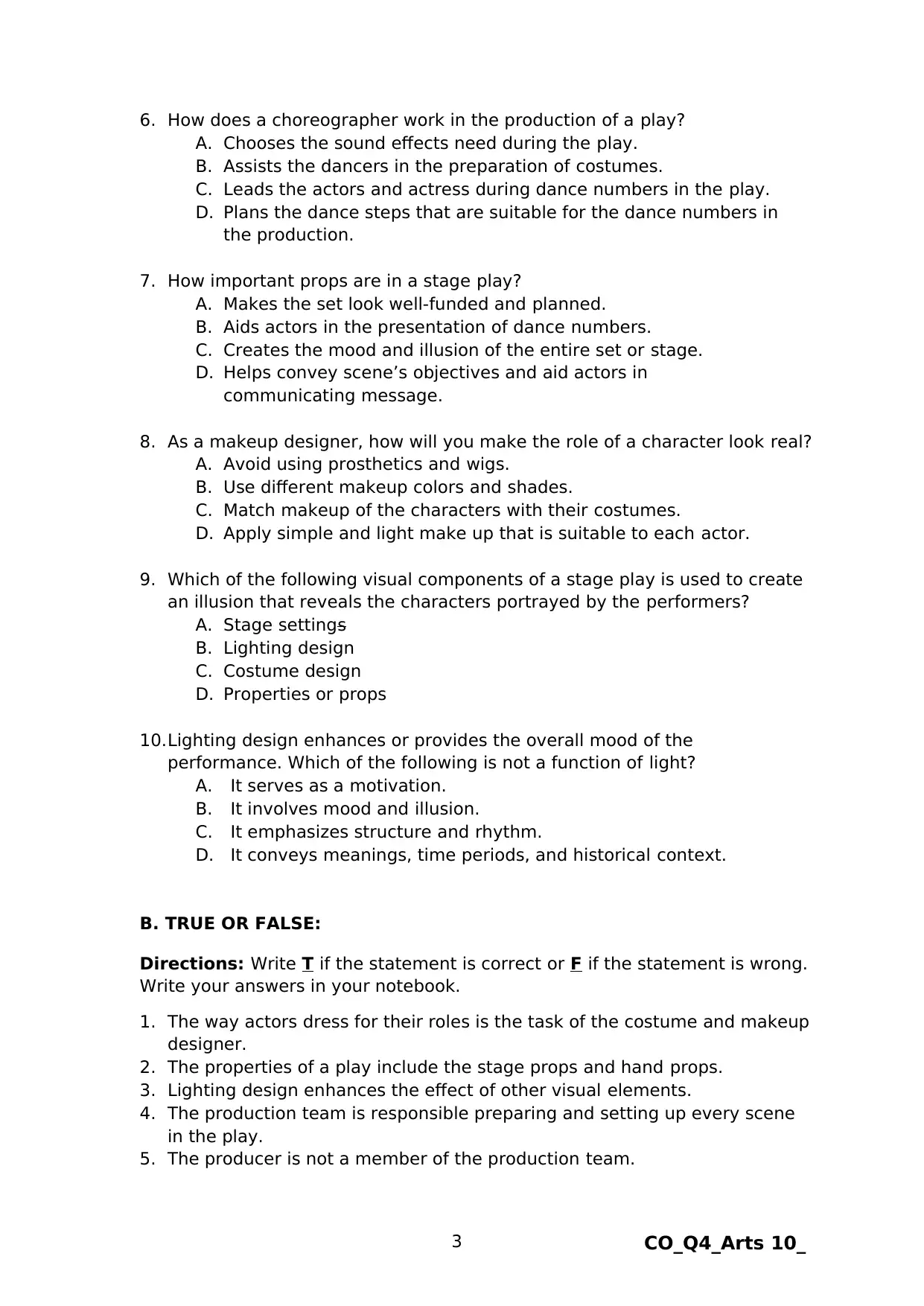
CO_Q4_Arts 10_
Module 2
3
6. How does a choreographer work in the production of a play?
A. Chooses the sound effects need during the play.
B. Assists the dancers in the preparation of costumes.
C. Leads the actors and actress during dance numbers in the play.
D. Plans the dance steps that are suitable for the dance numbers in
the production.
7. How important props are in a stage play?
A. Makes the set look well-funded and planned.
B. Aids actors in the presentation of dance numbers.
C. Creates the mood and illusion of the entire set or stage.
D. Helps convey scene’s objectives and aid actors in
communicating message.
8. As a makeup designer, how will you make the role of a character look real?
A. Avoid using prosthetics and wigs.
B. Use different makeup colors and shades.
C. Match makeup of the characters with their costumes.
D. Apply simple and light make up that is suitable to each actor.
9. Which of the following visual components of a stage play is used to create
an illusion that reveals the characters portrayed by the performers?
A. Stage settings
B. Lighting design
C. Costume design
D. Properties or props
10.Lighting design enhances or provides the overall mood of the
performance. Which of the following is not a function of light?
A. It serves as a motivation.
B. It involves mood and illusion.
C. It emphasizes structure and rhythm.
D. It conveys meanings, time periods, and historical context.
B. TRUE OR FALSE:
Directions: Write T if the statement is correct or F if the statement is wrong.
Write your answers in your notebook.
1. The way actors dress for their roles is the task of the costume and makeup
designer.
2. The properties of a play include the stage props and hand props.
3. Lighting design enhances the effect of other visual elements.
4. The production team is responsible preparing and setting up every scene
in the play.
5. The producer is not a member of the production team.
Module 2
3
6. How does a choreographer work in the production of a play?
A. Chooses the sound effects need during the play.
B. Assists the dancers in the preparation of costumes.
C. Leads the actors and actress during dance numbers in the play.
D. Plans the dance steps that are suitable for the dance numbers in
the production.
7. How important props are in a stage play?
A. Makes the set look well-funded and planned.
B. Aids actors in the presentation of dance numbers.
C. Creates the mood and illusion of the entire set or stage.
D. Helps convey scene’s objectives and aid actors in
communicating message.
8. As a makeup designer, how will you make the role of a character look real?
A. Avoid using prosthetics and wigs.
B. Use different makeup colors and shades.
C. Match makeup of the characters with their costumes.
D. Apply simple and light make up that is suitable to each actor.
9. Which of the following visual components of a stage play is used to create
an illusion that reveals the characters portrayed by the performers?
A. Stage settings
B. Lighting design
C. Costume design
D. Properties or props
10.Lighting design enhances or provides the overall mood of the
performance. Which of the following is not a function of light?
A. It serves as a motivation.
B. It involves mood and illusion.
C. It emphasizes structure and rhythm.
D. It conveys meanings, time periods, and historical context.
B. TRUE OR FALSE:
Directions: Write T if the statement is correct or F if the statement is wrong.
Write your answers in your notebook.
1. The way actors dress for their roles is the task of the costume and makeup
designer.
2. The properties of a play include the stage props and hand props.
3. Lighting design enhances the effect of other visual elements.
4. The production team is responsible preparing and setting up every scene
in the play.
5. The producer is not a member of the production team.
Paraphrase This Document
Need a fresh take? Get an instant paraphrase of this document with our AI Paraphraser
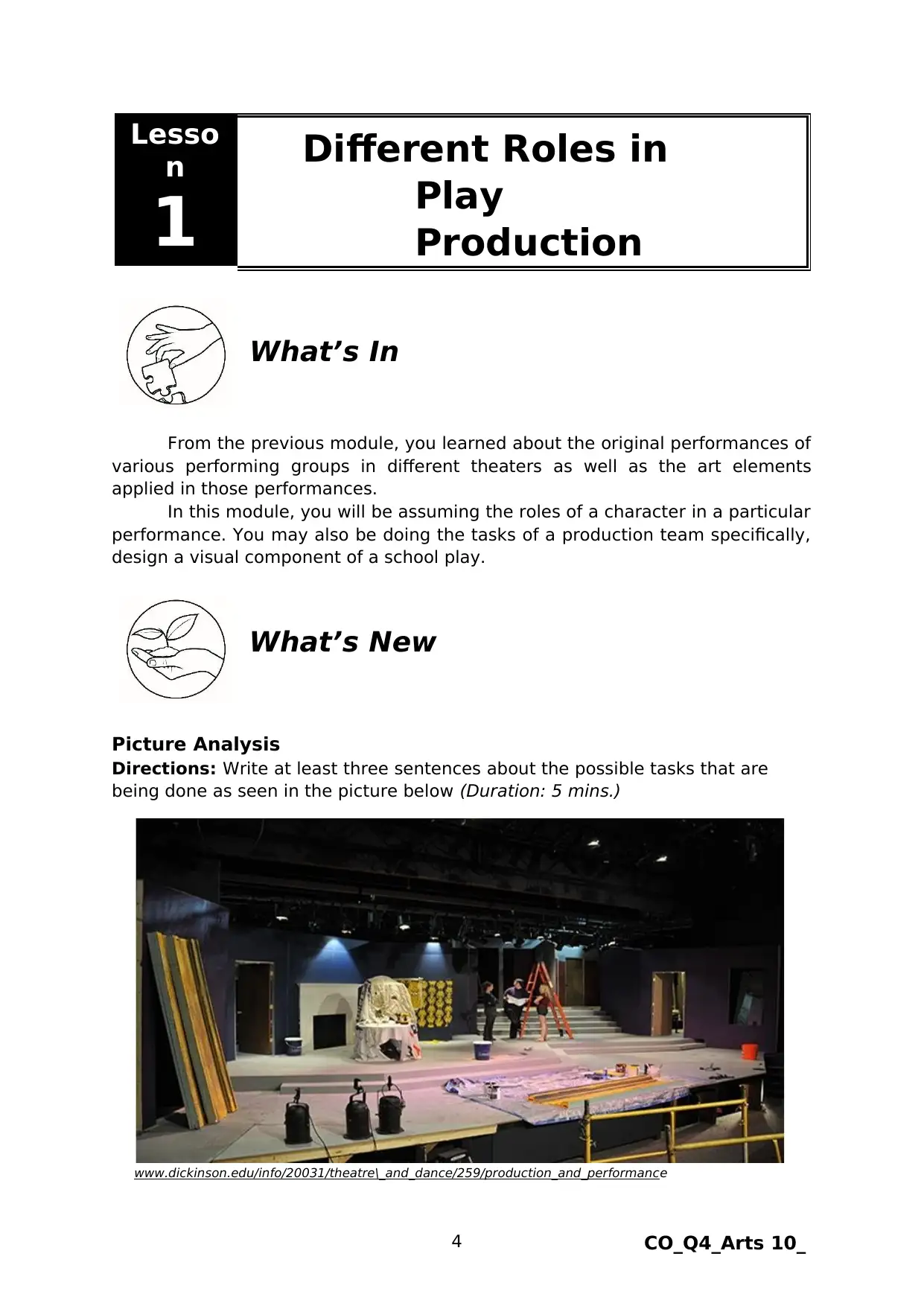
CO_Q4_Arts 10_
Module 2
4
Lesso
n
1
Different Roles in
Play
Production
What’s In
From the previous module, you learned about the original performances of
various performing groups in different theaters as well as the art elements
applied in those performances.
In this module, you will be assuming the roles of a character in a particular
performance. You may also be doing the tasks of a production team specifically,
design a visual component of a school play.
What’s New
Picture Analysis
Directions: Write at least three sentences about the possible tasks that are
being done as seen in the picture below (Duration: 5 mins.)
www.dickinson.edu/info/20031/theatre\_and_dance/259/production_and_performance
Module 2
4
Lesso
n
1
Different Roles in
Play
Production
What’s In
From the previous module, you learned about the original performances of
various performing groups in different theaters as well as the art elements
applied in those performances.
In this module, you will be assuming the roles of a character in a particular
performance. You may also be doing the tasks of a production team specifically,
design a visual component of a school play.
What’s New
Picture Analysis
Directions: Write at least three sentences about the possible tasks that are
being done as seen in the picture below (Duration: 5 mins.)
www.dickinson.edu/info/20031/theatre\_and_dance/259/production_and_performance
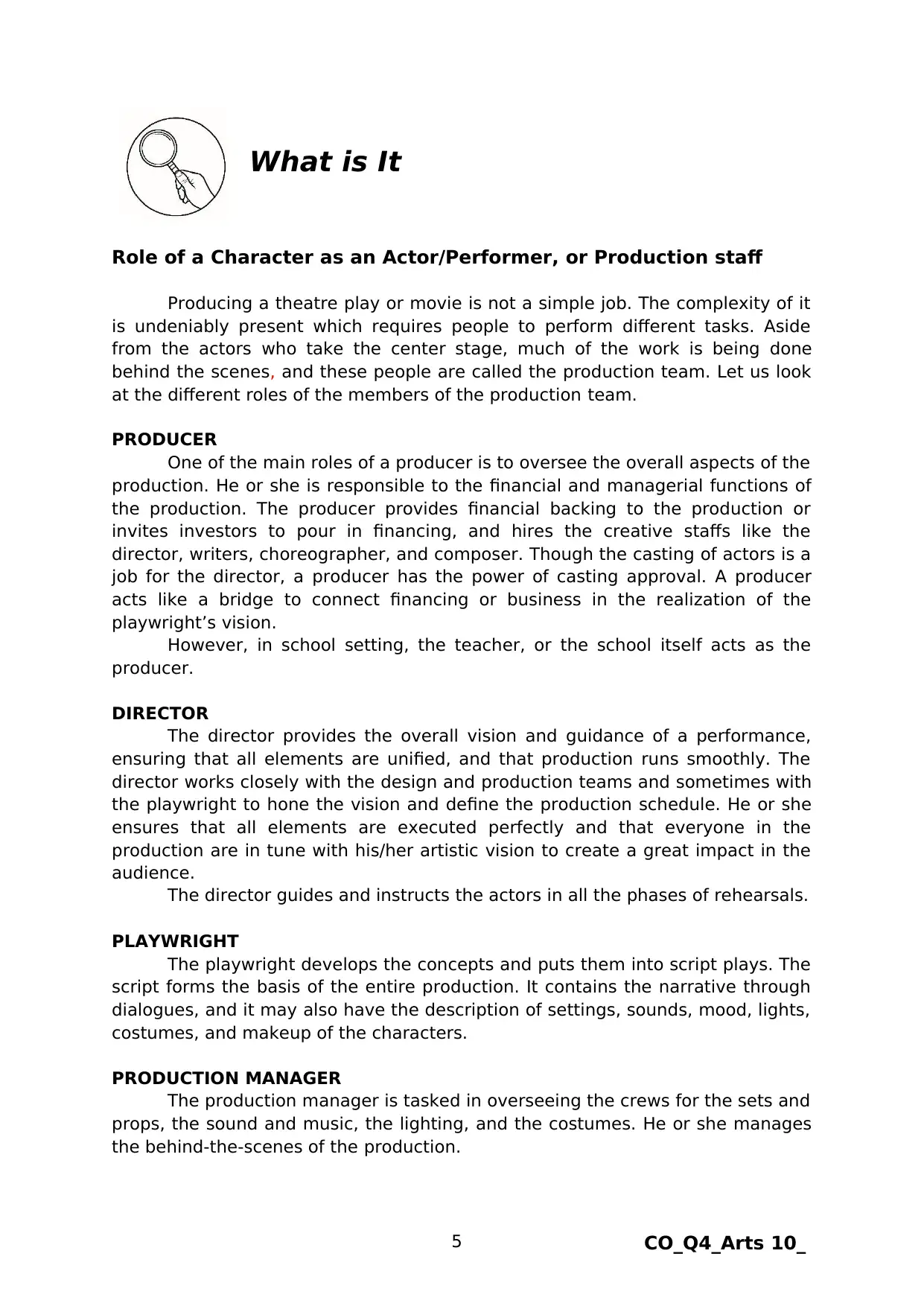
CO_Q4_Arts 10_
Module 2
5
What is It
Role of a Character as an Actor/Performer, or Production staff
Producing a theatre play or movie is not a simple job. The complexity of it
is undeniably present which requires people to perform different tasks. Aside
from the actors who take the center stage, much of the work is being done
behind the scenes, and these people are called the production team. Let us look
at the different roles of the members of the production team.
PRODUCER
One of the main roles of a producer is to oversee the overall aspects of the
production. He or she is responsible to the financial and managerial functions of
the production. The producer provides financial backing to the production or
invites investors to pour in financing, and hires the creative staffs like the
director, writers, choreographer, and composer. Though the casting of actors is a
job for the director, a producer has the power of casting approval. A producer
acts like a bridge to connect financing or business in the realization of the
playwright’s vision.
However, in school setting, the teacher, or the school itself acts as the
producer.
DIRECTOR
The director provides the overall vision and guidance of a performance,
ensuring that all elements are unified, and that production runs smoothly. The
director works closely with the design and production teams and sometimes with
the playwright to hone the vision and define the production schedule. He or she
ensures that all elements are executed perfectly and that everyone in the
production are in tune with his/her artistic vision to create a great impact in the
audience.
The director guides and instructs the actors in all the phases of rehearsals.
PLAYWRIGHT
The playwright develops the concepts and puts them into script plays. The
script forms the basis of the entire production. It contains the narrative through
dialogues, and it may also have the description of settings, sounds, mood, lights,
costumes, and makeup of the characters.
PRODUCTION MANAGER
The production manager is tasked in overseeing the crews for the sets and
props, the sound and music, the lighting, and the costumes. He or she manages
the behind-the-scenes of the production.
Module 2
5
What is It
Role of a Character as an Actor/Performer, or Production staff
Producing a theatre play or movie is not a simple job. The complexity of it
is undeniably present which requires people to perform different tasks. Aside
from the actors who take the center stage, much of the work is being done
behind the scenes, and these people are called the production team. Let us look
at the different roles of the members of the production team.
PRODUCER
One of the main roles of a producer is to oversee the overall aspects of the
production. He or she is responsible to the financial and managerial functions of
the production. The producer provides financial backing to the production or
invites investors to pour in financing, and hires the creative staffs like the
director, writers, choreographer, and composer. Though the casting of actors is a
job for the director, a producer has the power of casting approval. A producer
acts like a bridge to connect financing or business in the realization of the
playwright’s vision.
However, in school setting, the teacher, or the school itself acts as the
producer.
DIRECTOR
The director provides the overall vision and guidance of a performance,
ensuring that all elements are unified, and that production runs smoothly. The
director works closely with the design and production teams and sometimes with
the playwright to hone the vision and define the production schedule. He or she
ensures that all elements are executed perfectly and that everyone in the
production are in tune with his/her artistic vision to create a great impact in the
audience.
The director guides and instructs the actors in all the phases of rehearsals.
PLAYWRIGHT
The playwright develops the concepts and puts them into script plays. The
script forms the basis of the entire production. It contains the narrative through
dialogues, and it may also have the description of settings, sounds, mood, lights,
costumes, and makeup of the characters.
PRODUCTION MANAGER
The production manager is tasked in overseeing the crews for the sets and
props, the sound and music, the lighting, and the costumes. He or she manages
the behind-the-scenes of the production.
⊘ This is a preview!⊘
Do you want full access?
Subscribe today to unlock all pages.

Trusted by 1+ million students worldwide
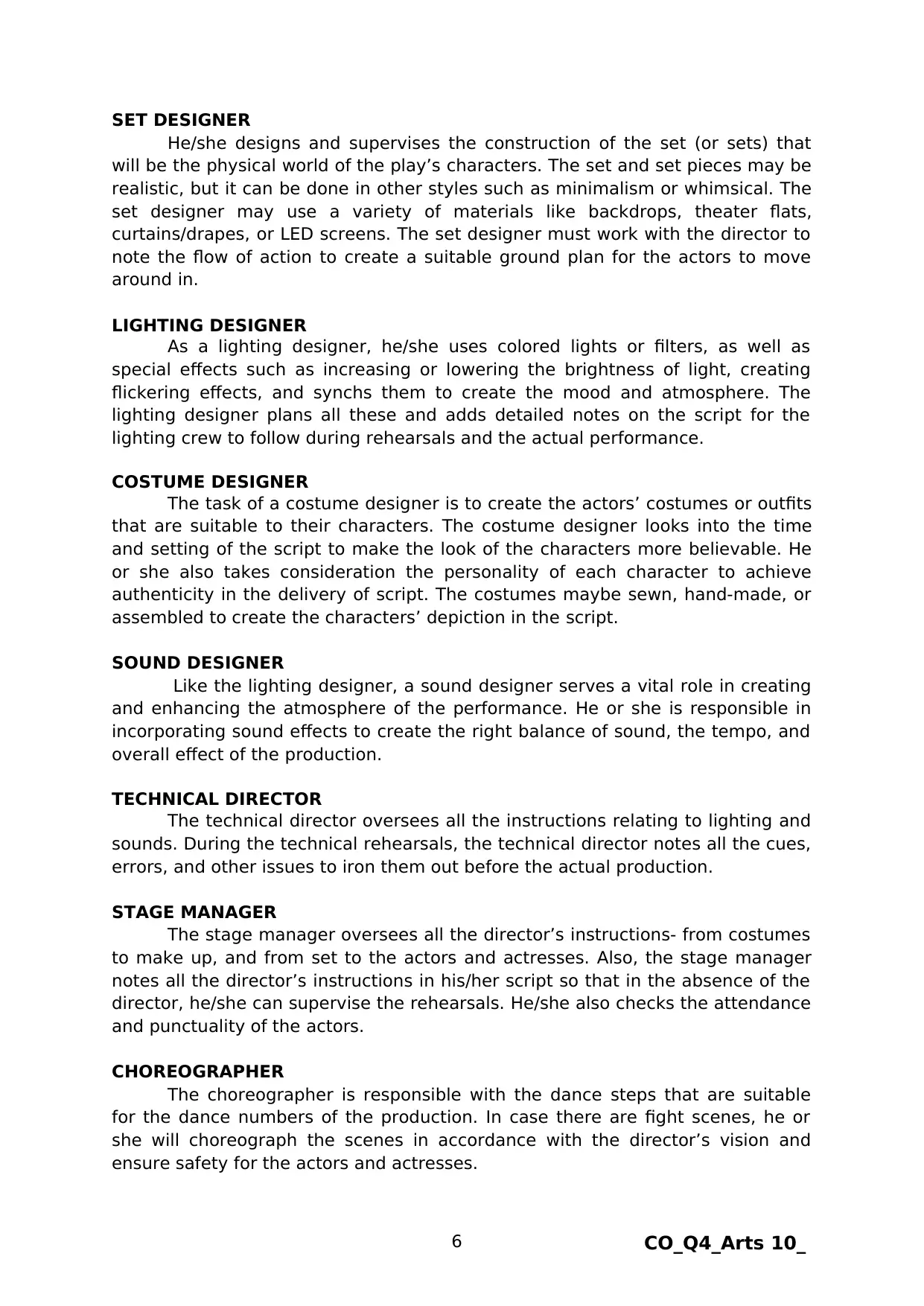
CO_Q4_Arts 10_
Module 2
6
SET DESIGNER
He/she designs and supervises the construction of the set (or sets) that
will be the physical world of the play’s characters. The set and set pieces may be
realistic, but it can be done in other styles such as minimalism or whimsical. The
set designer may use a variety of materials like backdrops, theater flats,
curtains/drapes, or LED screens. The set designer must work with the director to
note the flow of action to create a suitable ground plan for the actors to move
around in.
LIGHTING DESIGNER
As a lighting designer, he/she uses colored lights or filters, as well as
special effects such as increasing or lowering the brightness of light, creating
flickering effects, and synchs them to create the mood and atmosphere. The
lighting designer plans all these and adds detailed notes on the script for the
lighting crew to follow during rehearsals and the actual performance.
COSTUME DESIGNER
The task of a costume designer is to create the actors’ costumes or outfits
that are suitable to their characters. The costume designer looks into the time
and setting of the script to make the look of the characters more believable. He
or she also takes consideration the personality of each character to achieve
authenticity in the delivery of script. The costumes maybe sewn, hand-made, or
assembled to create the characters’ depiction in the script.
SOUND DESIGNER
Like the lighting designer, a sound designer serves a vital role in creating
and enhancing the atmosphere of the performance. He or she is responsible in
incorporating sound effects to create the right balance of sound, the tempo, and
overall effect of the production.
TECHNICAL DIRECTOR
The technical director oversees all the instructions relating to lighting and
sounds. During the technical rehearsals, the technical director notes all the cues,
errors, and other issues to iron them out before the actual production.
STAGE MANAGER
The stage manager oversees all the director’s instructions- from costumes
to make up, and from set to the actors and actresses. Also, the stage manager
notes all the director’s instructions in his/her script so that in the absence of the
director, he/she can supervise the rehearsals. He/she also checks the attendance
and punctuality of the actors.
CHOREOGRAPHER
The choreographer is responsible with the dance steps that are suitable
for the dance numbers of the production. In case there are fight scenes, he or
she will choreograph the scenes in accordance with the director’s vision and
ensure safety for the actors and actresses.
Module 2
6
SET DESIGNER
He/she designs and supervises the construction of the set (or sets) that
will be the physical world of the play’s characters. The set and set pieces may be
realistic, but it can be done in other styles such as minimalism or whimsical. The
set designer may use a variety of materials like backdrops, theater flats,
curtains/drapes, or LED screens. The set designer must work with the director to
note the flow of action to create a suitable ground plan for the actors to move
around in.
LIGHTING DESIGNER
As a lighting designer, he/she uses colored lights or filters, as well as
special effects such as increasing or lowering the brightness of light, creating
flickering effects, and synchs them to create the mood and atmosphere. The
lighting designer plans all these and adds detailed notes on the script for the
lighting crew to follow during rehearsals and the actual performance.
COSTUME DESIGNER
The task of a costume designer is to create the actors’ costumes or outfits
that are suitable to their characters. The costume designer looks into the time
and setting of the script to make the look of the characters more believable. He
or she also takes consideration the personality of each character to achieve
authenticity in the delivery of script. The costumes maybe sewn, hand-made, or
assembled to create the characters’ depiction in the script.
SOUND DESIGNER
Like the lighting designer, a sound designer serves a vital role in creating
and enhancing the atmosphere of the performance. He or she is responsible in
incorporating sound effects to create the right balance of sound, the tempo, and
overall effect of the production.
TECHNICAL DIRECTOR
The technical director oversees all the instructions relating to lighting and
sounds. During the technical rehearsals, the technical director notes all the cues,
errors, and other issues to iron them out before the actual production.
STAGE MANAGER
The stage manager oversees all the director’s instructions- from costumes
to make up, and from set to the actors and actresses. Also, the stage manager
notes all the director’s instructions in his/her script so that in the absence of the
director, he/she can supervise the rehearsals. He/she also checks the attendance
and punctuality of the actors.
CHOREOGRAPHER
The choreographer is responsible with the dance steps that are suitable
for the dance numbers of the production. In case there are fight scenes, he or
she will choreograph the scenes in accordance with the director’s vision and
ensure safety for the actors and actresses.
Paraphrase This Document
Need a fresh take? Get an instant paraphrase of this document with our AI Paraphraser
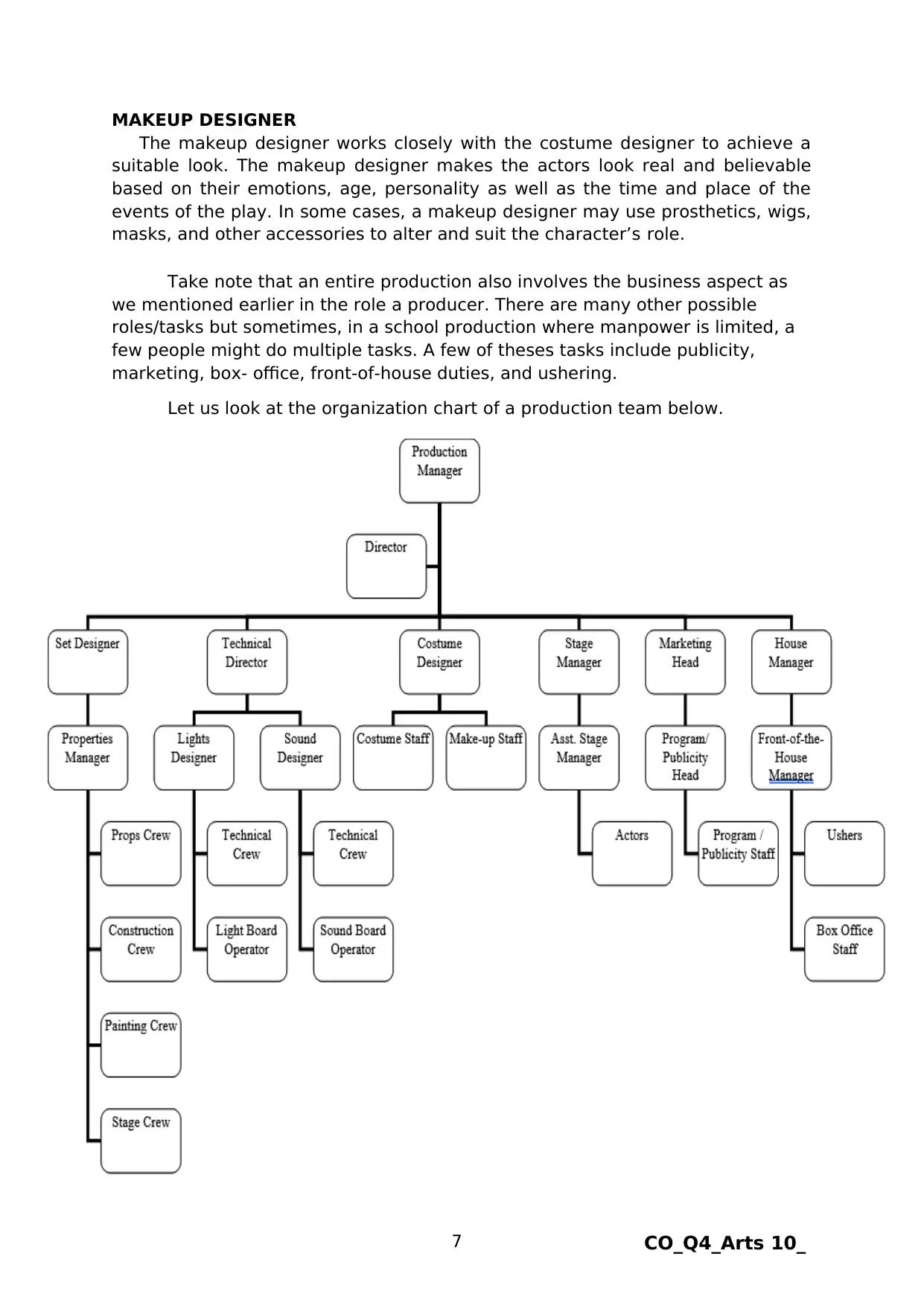
CO_Q4_Arts 10_
Module 2
7
MAKEUP DESIGNER
The makeup designer works closely with the costume designer to achieve a
suitable look. The makeup designer makes the actors look real and believable
based on their emotions, age, personality as well as the time and place of the
events of the play. In some cases, a makeup designer may use prosthetics, wigs,
masks, and other accessories to alter and suit the character’s role.
Take note that an entire production also involves the business aspect as
we mentioned earlier in the role a producer. There are many other possible
roles/tasks but sometimes, in a school production where manpower is limited, a
few people might do multiple tasks. A few of theses tasks include publicity,
marketing, box- office, front-of-house duties, and ushering.
Let us look at the organization chart of a production team below.
Module 2
7
MAKEUP DESIGNER
The makeup designer works closely with the costume designer to achieve a
suitable look. The makeup designer makes the actors look real and believable
based on their emotions, age, personality as well as the time and place of the
events of the play. In some cases, a makeup designer may use prosthetics, wigs,
masks, and other accessories to alter and suit the character’s role.
Take note that an entire production also involves the business aspect as
we mentioned earlier in the role a producer. There are many other possible
roles/tasks but sometimes, in a school production where manpower is limited, a
few people might do multiple tasks. A few of theses tasks include publicity,
marketing, box- office, front-of-house duties, and ushering.
Let us look at the organization chart of a production team below.
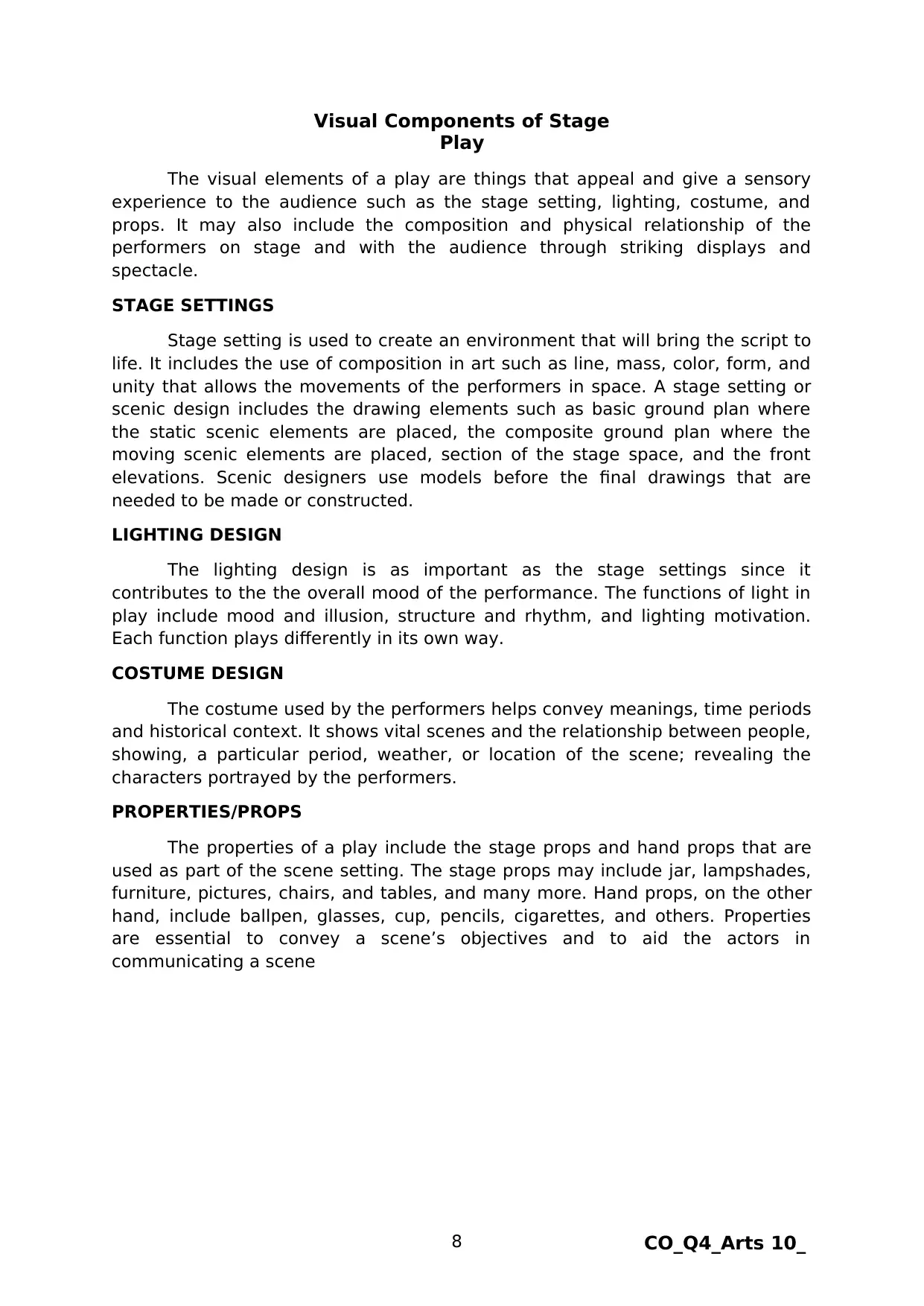
CO_Q4_Arts 10_
Module 2
8
Visual Components of Stage
Play
The visual elements of a play are things that appeal and give a sensory
experience to the audience such as the stage setting, lighting, costume, and
props. It may also include the composition and physical relationship of the
performers on stage and with the audience through striking displays and
spectacle.
STAGE SETTINGS
Stage setting is used to create an environment that will bring the script to
life. It includes the use of composition in art such as line, mass, color, form, and
unity that allows the movements of the performers in space. A stage setting or
scenic design includes the drawing elements such as basic ground plan where
the static scenic elements are placed, the composite ground plan where the
moving scenic elements are placed, section of the stage space, and the front
elevations. Scenic designers use models before the final drawings that are
needed to be made or constructed.
LIGHTING DESIGN
The lighting design is as important as the stage settings since it
contributes to the the overall mood of the performance. The functions of light in
play include mood and illusion, structure and rhythm, and lighting motivation.
Each function plays differently in its own way.
COSTUME DESIGN
The costume used by the performers helps convey meanings, time periods
and historical context. It shows vital scenes and the relationship between people,
showing, a particular period, weather, or location of the scene; revealing the
characters portrayed by the performers.
PROPERTIES/PROPS
The properties of a play include the stage props and hand props that are
used as part of the scene setting. The stage props may include jar, lampshades,
furniture, pictures, chairs, and tables, and many more. Hand props, on the other
hand, include ballpen, glasses, cup, pencils, cigarettes, and others. Properties
are essential to convey a scene’s objectives and to aid the actors in
communicating a scene
Module 2
8
Visual Components of Stage
Play
The visual elements of a play are things that appeal and give a sensory
experience to the audience such as the stage setting, lighting, costume, and
props. It may also include the composition and physical relationship of the
performers on stage and with the audience through striking displays and
spectacle.
STAGE SETTINGS
Stage setting is used to create an environment that will bring the script to
life. It includes the use of composition in art such as line, mass, color, form, and
unity that allows the movements of the performers in space. A stage setting or
scenic design includes the drawing elements such as basic ground plan where
the static scenic elements are placed, the composite ground plan where the
moving scenic elements are placed, section of the stage space, and the front
elevations. Scenic designers use models before the final drawings that are
needed to be made or constructed.
LIGHTING DESIGN
The lighting design is as important as the stage settings since it
contributes to the the overall mood of the performance. The functions of light in
play include mood and illusion, structure and rhythm, and lighting motivation.
Each function plays differently in its own way.
COSTUME DESIGN
The costume used by the performers helps convey meanings, time periods
and historical context. It shows vital scenes and the relationship between people,
showing, a particular period, weather, or location of the scene; revealing the
characters portrayed by the performers.
PROPERTIES/PROPS
The properties of a play include the stage props and hand props that are
used as part of the scene setting. The stage props may include jar, lampshades,
furniture, pictures, chairs, and tables, and many more. Hand props, on the other
hand, include ballpen, glasses, cup, pencils, cigarettes, and others. Properties
are essential to convey a scene’s objectives and to aid the actors in
communicating a scene
⊘ This is a preview!⊘
Do you want full access?
Subscribe today to unlock all pages.

Trusted by 1+ million students worldwide
1 out of 21
Your All-in-One AI-Powered Toolkit for Academic Success.
+13062052269
info@desklib.com
Available 24*7 on WhatsApp / Email
![[object Object]](/_next/static/media/star-bottom.7253800d.svg)
Unlock your academic potential
Copyright © 2020–2025 A2Z Services. All Rights Reserved. Developed and managed by ZUCOL.